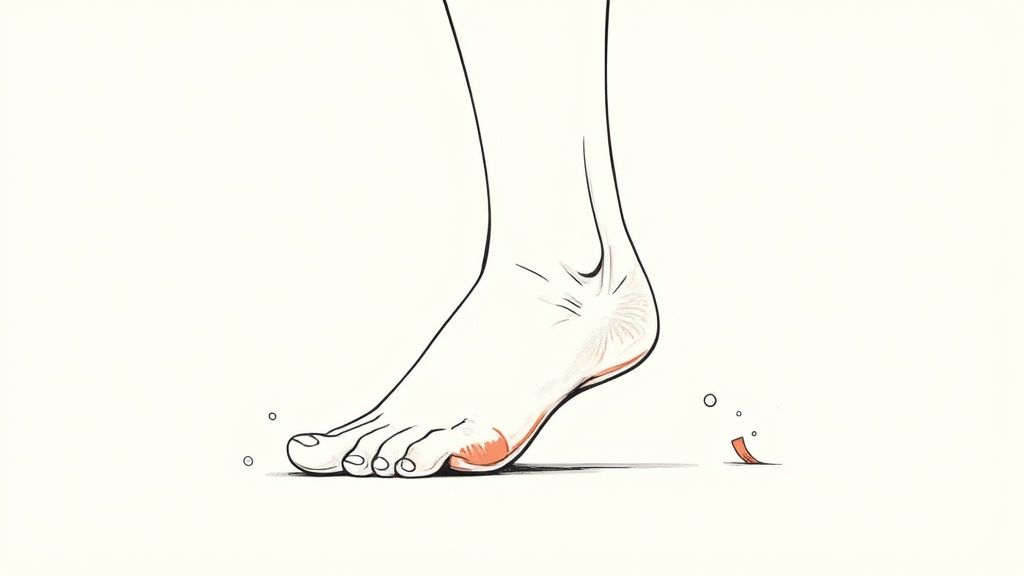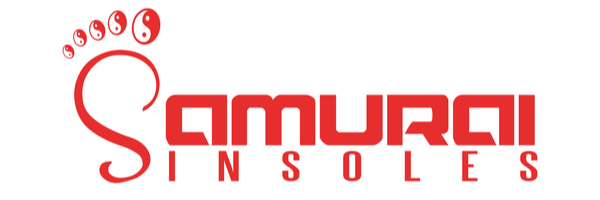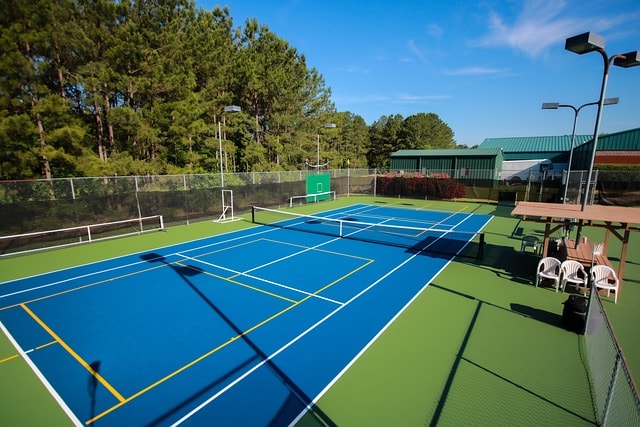When Your Feet Work Too Hard: Understanding Overpronation
Think of your foot like a finely tuned race car suspension, designed to absorb the bumps and keep the ride smooth. Every time your foot hits the ground, it naturally rolls inward a bit. This is called pronation, and it's a perfectly normal, essential part of walking and running. But sometimes, like a worn-out shock absorber, this system can overdo it. That’s overpronation: your foot rolls inward excessively, putting extra stress on your arch and the surrounding structures.

This image shows the difference between a neutral foot, an overpronated foot, and an underpronated foot (also called supination). Notice how the overpronated foot rolls inward significantly more, putting a strain on the ankle and arch.
Understanding how overpronation works is the first step to finding the right fix. Many runners mistakenly think it’s a flaw, but it's really just a variation in how your foot moves. Insoles for overpronation running can provide the extra support needed to manage this excessive inward roll. Think of them as giving your foot's natural suspension a helpful boost.
What Causes Overpronation?
Overpronation rarely has a single cause. It’s usually a combination of factors. Your genes can play a role, as can the natural structure of your feet, such as flat feet or low arches. Other contributing factors include weak muscles in the foot and ankle, wearing the wrong shoes, and even repetitive stress from running.
Regardless of the underlying cause, the effects of overpronation can be similar. That’s why recognizing the signs is so important.
Recognizing the Signs
One of the easiest ways to spot overpronation is to check your shoes. Noticeable wear and tear on the inner edges, especially around the ball of your foot and heel, is a telltale sign. This uneven wear pattern shows how your foot collapses inward with each step.
You might also feel discomfort or pain in your arches, ankles, or knees. Because overpronation can affect your entire body’s alignment, you might even experience pain in your hips or back. For some runners, common injuries like shin splints and plantar fasciitis can be linked to overpronation.
This leads us to the important next step: finding the right support. Insoles designed for overpronation running can offer targeted support and make a real difference in your comfort and performance on the road.
The Domino Effect: How Overpronation Impacts Your Running
Imagine a bowling ball hooking down the lane instead of rolling straight. That’s a simplified way to picture what happens to your foot when you overpronate. This excessive inward roll isn't just a quirk of foot mechanics; it triggers a chain reaction that can affect your whole body. With every stride, that extra roll sends a shockwave up your leg, forcing your ankles, knees, hips, and even your lower back to work overtime to compensate.
Think of Sarah, a runner who recently increased her mileage and started experiencing persistent knee pain. Stretching, foam rolling, and rest provided no relief. Finally, a physical therapist identified the culprit: overpronation. The inward roll of her feet was placing extra stress on her knees, causing inflammation and pain. Sarah’s story isn't unique; it highlights how overpronation can be the hidden cause of seemingly unrelated problems.
The Ripple Effect on Your Body
This misalignment can set the stage for common running injuries. Overpronation can overstretch the plantar fascia, the band of tissue that supports the arch of your foot, leading to the sharp pain of plantar fasciitis. It can also strain the muscles in your shins, making you susceptible to shin splints. Furthermore, the increased stress on the iliotibial (IT) band, which runs along the outside of your thigh, can contribute to IT band syndrome. These injuries can sideline even the most dedicated runners, making it essential to address the underlying issue of overpronation.
The growing recognition of these biomechanical links has fueled a surge in demand for solutions. The use of insoles for overpronation running is increasing, driven by greater awareness of foot health and advancements in orthotic technology. In 2022, the global insole and orthotic shoe market was valued at $5.59 billion and is projected to reach $8.04 billion by 2030. This growth reflects the needs of runners like Sarah, seeking support to prevent injuries and improve their running experience. Find out more about insole market growth here.
Breaking the Chain
Recognizing the signs of overpronation and understanding its impact are the first steps toward preventing these issues. Look for uneven wear on the inside edges of your shoes, a tendency for your ankles to roll inward, and persistent pain in your feet, ankles, knees, or hips. Dismissing these signals can lead to more significant problems later on. Addressing overpronation early on, often with the help of insoles for overpronation running, can keep these issues from becoming chronic, allowing you to stay active and enjoy pain-free running.
Inside the Insole: What Actually Makes a Difference
Choosing the right insoles for overpronation running isn't about grabbing the first pair off the shelf. It's about understanding how your foot works and how the right support can make your stride more efficient. Think of it like choosing the right suspension for a car – you wouldn't put heavy-duty shocks on a nimble sports car, just like you wouldn't put flimsy springs on a rugged truck. This section dives into the key parts of an effective insole.
The Science of Support
The arch support is the MVP of an overpronation insole. Imagine a bridge holding up a busy road. A good arch support works the same way, stopping your foot's arch from collapsing inwards. The heel cup is another essential piece, cradling your heel and providing a stable base. It’s the foundation of your foot, keeping everything aligned and reducing extra movement.
Material Matters
The materials in an insole make a big difference in both comfort and how long they last. EVA (ethylene-vinyl acetate) is a popular choice known for its cushioning and shock absorption. Polyurethane is usually firmer and more durable. Some insoles use a mix of both to get the benefits of each – a strong core with a comfy top layer. These material choices affect not only how the insole feels, but also how it performs over many miles of running. Interestingly, the market for orthopedic insoles, including those for overpronation, is growing rapidly. It's expected to increase from $3.2 billion in 2025 to $6.7 billion by 2035, thanks to more people focusing on foot health and advancements in materials. Learn more about insole market projections here.
Motion Control vs. Flexibility: Finding the Balance
Insole designers often grapple with the trade-off between motion control and flexibility. Stiff insoles give you lots of control, limiting pronation, but can feel restrictive. More flexible insoles allow your foot to move more naturally, which some runners prefer, but they might not offer enough support for severe overpronation. The sweet spot is an insole that provides enough support to manage overpronation while still allowing natural foot movement. This balance is key for both comfort and performance on the road.
To help you understand the various technologies used in insoles, take a look at the following comparison:
Insole Technology Comparison for Overpronation Support A detailed comparison of different insole technologies and their effectiveness for managing overpronation in running
| Technology Type | Support Level | Best For | Durability | Price Range |
|---|---|---|---|---|
| Molded EVA | Moderate | Mild overpronation, everyday use | Good | $20 - $50 |
| Dual-density EVA | Moderate to High | Moderate overpronation, runners | Very Good | $30 - $70 |
| Polyurethane | High | Severe overpronation, athletes | Excellent | $40 - $100 |
| Carbon Fiber | Maximum | High-impact activities, maximum stability | Excellent | $80 - $150 |
| Gel Inserts | Low to Moderate | Added cushioning, shock absorption | Fair | $15 - $40 |
This table highlights the different support levels and durability offered by various insole technologies. It's important to choose a technology that matches your specific needs and activity level. For instance, while gel inserts might provide extra comfort, they might not offer the long-term support needed for serious runners with overpronation.
Customized Comfort: A Growing Trend
Personalized insoles are becoming increasingly popular. Brands are now using 3D printing and smart sensors to make insoles that perfectly fit each individual’s foot. This custom approach can be a game-changer for runners with overpronation, giving them support exactly where it's needed. Choosing insoles for overpronation is more than just buying something off the shelf; it's about knowing how all the parts work together to create an insole that truly meets your needs.
Finding Your Perfect Fit: The Smart Selection Process
Choosing insoles for overpronation isn't a one-size-fits-all thing. It's more like finding the right running shoe—a personal journey. We'll walk you through a smart selection process, taking into account your foot structure, running style, and what you need as a runner.
Assessing Your Foot and Pronation
First, get to know your feet. High arches? Flat feet? Somewhere in between? This tells you how much arch support you'll need. Then, check how much you overpronate. Look at the wear and tear on your running shoes. Excessive wear on the inner edges? That points to more overpronation and the need for stronger support. A simple "wet foot test"—wet your foot and step on a dark surface—can visually show your arch type and pronation pattern.
Factors Influencing Your Choice
Think about your running routine. Weekly mileage? Typical running surfaces? Trail runners on uneven terrain need different insoles than road runners on pavement. Past injuries, like plantar fasciitis or shin splints, also matter. These might require special features in your insoles.
Interestingly, the insole market is growing with the rising interest in sports and fitness. The global foot insoles market is projected to grow by USD 2.2 billion between 2025 and 2029, with a CAGR of almost 8.3%. This shows how much focus there is on foot health and performance these days. Find out more about this growing market here.
The First Run and Beyond
Those first few runs with new insoles are important. Notice how your feet feel. A little initial discomfort is normal as your feet adjust, but ongoing pain is a sign they're not the right fit. Knowing the difference between normal adjustment and a bad fit is key. Slowly increase your mileage with the insoles so your body can get used to them.
Custom vs. Over-the-Counter: Making the Right Call
Should you go for custom orthotics or over-the-counter insoles? It depends on your needs and budget. Custom orthotics are made just for your foot, offering the most personalized support, but they're pricier. Over-the-counter options, like Samurai Insoles, offer various support levels and features at a lower cost. They're a good place to start, especially for runners with mild to moderate overpronation. If you’re not sure, talk to a podiatrist or physical therapist. They can evaluate your needs and recommend the best solution. Choosing the right insoles is an investment in your running health and performance over time. It takes some experimenting and careful thought.
The Break-In Period: Why It Matters
Think of your muscles and tendons like elastic bands. Insoles subtly change how your feet work, and those "elastic bands" need time to adapt to the new alignment. The break-in period gives them that time, preventing undue stress and strain. It's not just a good idea; it's essential for long-term comfort.
A Gradual Approach to Integration
Start slow. Wear your insoles for 30-60 minutes at a time while walking or doing other low-impact activities. Then, gradually increase the time and intensity by adding short runs. Pay attention to your body. A little soreness is okay – it's a sign of adaptation. But sharp pain means you're pushing too hard. Dial it back a bit, and let your feet acclimate at their own pace.
Recognizing Normal Discomfort vs. Warning Signs
As you adjust, you might feel some mild discomfort. This is usually temporary, like the muscle soreness after a good workout. However, persistent pain, numbness, or tingling are red flags. Think of it this way: muscle soreness is like your body saying, "I'm working hard!" Sharp pain is like it yelling, "Something's wrong!" If you experience any of these warning signs, stop using the insoles and talk to a podiatrist or physical therapist. They can help you figure out the best course of action.
Maintaining Consistency While Adapting
Keep running! Don't let the break-in period derail your training. If you usually run five days a week, maintain that schedule, but adjust your mileage and intensity. For example, if you typically run five miles, reduce it to three or four while wearing your new insoles. This keeps your fitness up while your feet get used to the added support.
Addressing Common Concerns
Worried about how insoles will affect your shoe fit? That's a common concern. Some insoles, like the Samurai Insoles Ninjas, are thin and designed to fit under existing insoles, minimizing changes to shoe volume. Others might require a slightly larger shoe size or thinner socks. Experiment a little – try different lacing techniques too. You'll likely find a comfortable setup that works for you.
Transitioning to new insoles takes patience and a little experimentation. But by following these guidelines and listening to your body, you'll be well on your way to more comfortable, efficient, and injury-free runs.
Your Complete Overpronation Success Strategy
While the right insoles for overpronation running can be real difference-makers, they work best as part of a bigger picture. Think of it like building a house – insoles are the foundation, but you still need walls, a roof, and everything else to make it a home. This section explores the other essential pieces that work together with insoles to create a truly supportive system for your feet.
Strengthening Your Foundation: Targeted Exercises
Just as a strong core supports your whole body, strong foot and ankle muscles are essential for managing overpronation. Imagine these muscles as the internal scaffolding of your foot. Specific exercises can strengthen this scaffolding, providing support from the inside out.
- Toe Curls: These strengthen the small muscles within your feet, improving arch stability. Try picking up small objects with your toes – think of it like a workout for your feet!
- Calf Raises: Simple yet effective, calf raises build strength in your calf muscles, which play a key role in controlling foot motion.
- Ankle Circles: Improve ankle flexibility and range of motion, helping you develop a more balanced stride.
Remember, these exercises aren't about building big muscles. They're about developing functional strength that enhances the support your insoles provide. This combined approach is far more effective than just relying on insoles alone.
Refining Your Form: Running with Intention
How you run really does matter. Overpronation can be made worse by inefficient running form. Think of a car with its wheels out of alignment – the tires are going to wear down unevenly. Poor running form can similarly place extra stress on certain parts of your foot.
- Cadence: Upping your step frequency can actually lessen the impact forces that contribute to overpronation. Think shorter, quicker steps.
- Foot Strike: Aiming to land midfoot, as opposed to striking hard on your heel, helps distribute the impact forces more evenly.
- Body Posture: Running tall with your core engaged promotes good alignment throughout your body, reducing stress on your feet.
These tweaks to your form, along with your insoles, create a more efficient and balanced running style, lessening the strain on your feet and helping to prevent injuries.
Shoe Selection: The Right Fit for Success
Just as insoles aren't one-size-fits-all, neither are running shoes. Your shoes are the external support system that works in tandem with the internal support from your insoles and strengthened muscles.
- Stability Shoes: Often, these shoes have built-in features to counter excessive pronation. They can be a great complement to your insoles for comprehensive support.
- Proper Fit: Make sure your shoes are the correct size and width. Shoes that are too tight or too loose can worsen any existing foot issues.
- Consider Orthotic-Friendly Shoes: Some shoes are designed with removable insoles, making it simple to add your own custom orthotics.
The right combination of insoles and shoes is vital. Together, they create a support system that really optimizes your running experience.
Recovery: Supporting Long-Term Foot Health
Recovery is just as important as your training. Think of it like any well-maintained machine—it needs downtime. Your feet are no different. Proper recovery lets your muscles and tissues repair and rebuild, making them more resistant to overpronation-related stress.
- Rest: Giving your feet adequate rest helps them recover from the demands of running.
- Ice: Icing sore areas can reduce inflammation and help speed up healing.
- Stretching: Regular stretching maintains flexibility and prevents tightness in the muscles that support your arches.
These recovery techniques, combined with the other strategies we’ve covered, create a complete approach to overpronation management. This isn't just about fixing a problem; it's about building a stronger running foundation from the ground up. Ready to manage your overpronation and feel the difference? Explore the full range of Samurai Insoles designed for targeted support: Samurai Insoles



